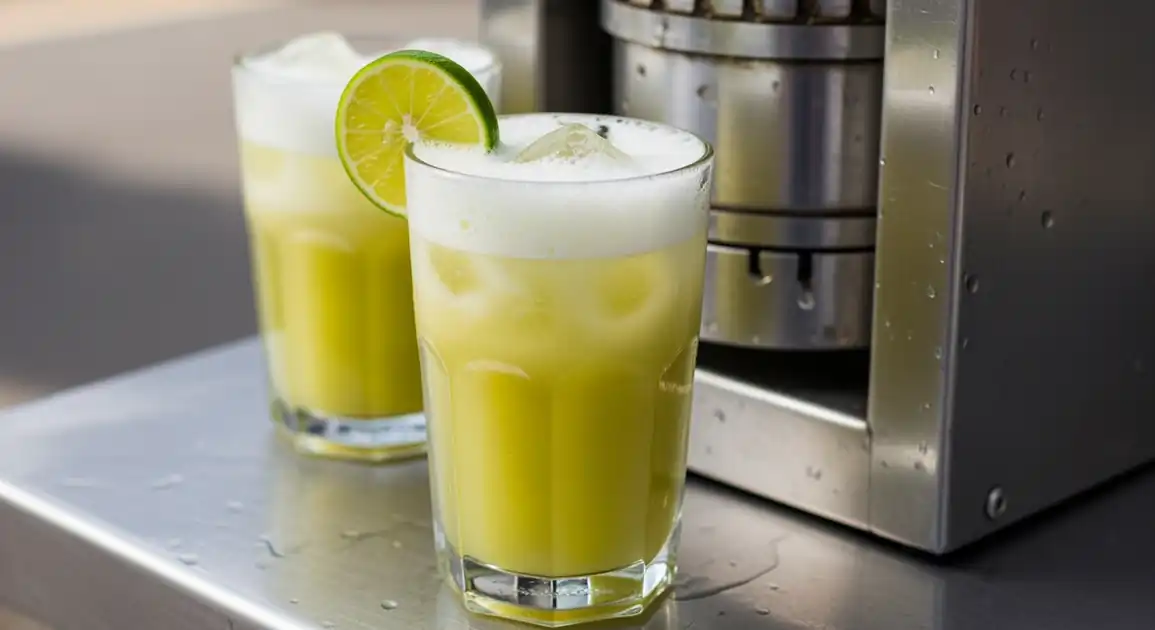Caldo de Cana (Sugarcane Juice)
Caldo de Cana / Garapa

Description
In Rio de Janeiro, Caldo de Cana is a beloved refreshment, readily available throughout the city. Find it at the numerous 'feiras livres' in neighborhoods like Glória, Laranjeiras, or Copacabana, from street vendors near transport hubs like Central do Brasil, and even at some beachside kiosks ('quiosques') along Copacabana or Ipanema.
Dietary Information
Serving information
Serving style
Served cold in plastic cups, almost always offered 'com limão' (with lime). Ice is common due to the heat, but order 'sem gelo' if preferred.
Quick facts
Feiras: Weekend mornings (approx. 7 AM - 1 PM). Street Vendors: Daytime (approx. 9 AM - 6 PM). Beach Kiosks: Longer hours, often 10 AM - 8 PM or later.
Safety Tips
What to Look For
-
Juice pressed fresh to order ('na hora')
Ensures maximum freshness and minimizes time for bacterial growth or fermentation.
-
Clean pressing machine ('moenda')
Check for absence of dirt, grime, rust, mold, old cane residue, and insects, especially around rollers and collection spout.
-
Vendor uses clean cups and utensils
Cups should be new/clean. Observe handling practices to avoid contamination.
-
Vendor washes hands or uses clean practices
Basic hygiene is crucial when handling food/drinks.
-
Optional: Juice is strained through a clean filter
Removes small cane fibers, improving texture and possibly removing some contaminants.
-
Optional: Ice looks clear and commercially made (if using)
Cloudy or block ice might be from questionable water sources. 'Sem gelo' (no ice) is the safest option if unsure.
What to avoid
-
Pre-pressed juice stored in jugs or containers
Juice degrades quickly. Pre-pressed juice has higher risk of fermentation and contamination.
-
Visibly dirty 'moenda' machine or surrounding area
Clear sign of poor hygiene standards. Avoid vendors with flies buzzing around the machine.
-
Re-used or dirty-looking cups
Obvious hygiene risk.
-
Vendor handles money and then juice/cups without cleaning hands
Risk of cross-contamination.
-
Juice with a sour or fermented smell
Indicates the juice is old or starting to spoil.
Price information
Price range
Budget tips
- 'Feiras livres' usually offer the best prices.
- Beach kiosks ('quiosques') tend to be the most expensive.
- Look for vendors just off the main tourist strips for potentially better prices.
Value indicators
- Pressed fresh ('feito na hora').
- Cleanliness of stall and machine.
- Served cold, lime included.
- Generous portion size for the price.
Where to Find This Dish
Feiras Livres (Various Neighborhoods)
Weekly markets in areas like Copacabana (various days/locations), Ipanema (Praça General Osório - Sundays), Glória (Sundays), Laranjeiras (Saturdays).
Praça General Osório, Parque do Flamengo vicinity (Glória)
Weekend mornings (7 AM - 1 PM)
Central do Brasil Area
High concentration of street vendors catering to commuters near the main train/bus station.
Central do Brasil Station
Daytime (weekdays)
Beach Kiosks ('Quiosques')
Some kiosks along Copacabana, Ipanema, and Leblon beaches sell Caldo de Cana.
Orla (beachfront promenade) of Copacabana/Ipanema
Daytime (especially weekends)
Saara Market (Centro)
Street vendors scattered within the bustling downtown shopping district.
Rua Uruguaiana, Rua da Alfândega
Weekdays (business hours, approx 9 AM - 6 PM)
Vendor Tips
- 'Feiras' offer the most authentic pairing experience with pastel.
- Specify 'sem gelo' if you are concerned about ice quality, especially away from main tourist areas.
- Beach kiosk prices will be higher, but the location is convenient.
- Vendors in Centro/Saara cater to locals and can be very efficient.
How to Order
Regional Variations
-
Beachside Availability
(Venda na Praia)
More likely to find vendors directly on or near the beach promenade in Rio compared to some other Brazilian cities.
-
Emphasis on 'Com Limão'
(Caldo de Cana com Limão)
Adding lime seems particularly standard and expected in Rio.
Cultural context
History
Sugarcane cultivation has been central to Brazil's economy and history since the colonial era. Caldo de Cana emerged as a simple, accessible way for people to consume a product of this abundant crop. It became a widespread, affordable source of quick energy and refreshment for workers and the general population. Its presence, particularly alongside pastel at 'feiras livres', is a deeply ingrained cultural tradition.
Local significance
A staple Carioca refreshment, perfect for the tropical climate. Part of the rhythm of weekend market visits and daily life.
Eating customs
- Drinking it immediately while standing is typical.
- Lime ('limão') is almost always expected and offered.
- Cariocas often drink it very cold, usually with ice.